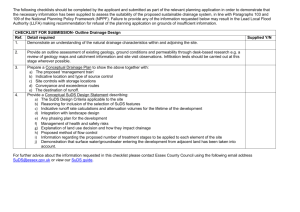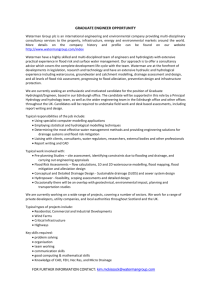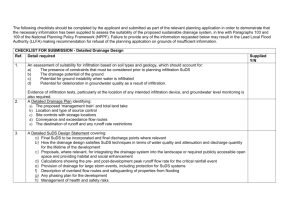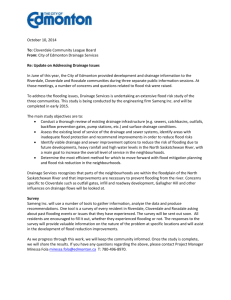integrated water resources management practices
advertisement
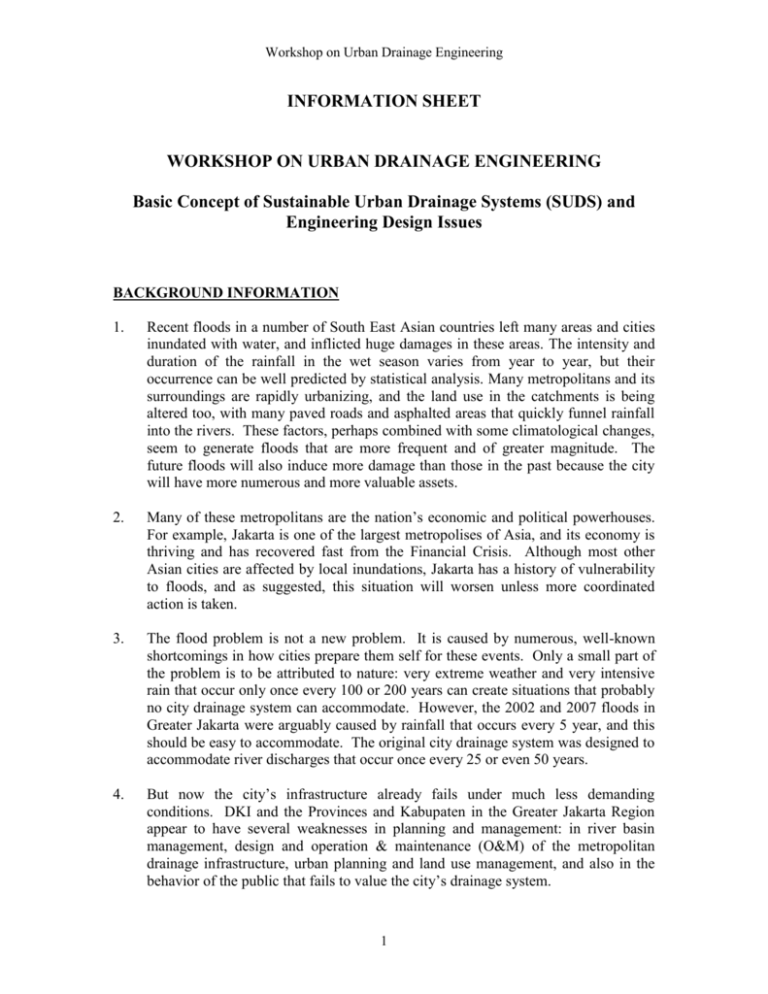
Workshop on Urban Drainage Engineering INFORMATION SHEET WORKSHOP ON URBAN DRAINAGE ENGINEERING Basic Concept of Sustainable Urban Drainage Systems (SUDS) and Engineering Design Issues BACKGROUND INFORMATION 1. Recent floods in a number of South East Asian countries left many areas and cities inundated with water, and inflicted huge damages in these areas. The intensity and duration of the rainfall in the wet season varies from year to year, but their occurrence can be well predicted by statistical analysis. Many metropolitans and its surroundings are rapidly urbanizing, and the land use in the catchments is being altered too, with many paved roads and asphalted areas that quickly funnel rainfall into the rivers. These factors, perhaps combined with some climatological changes, seem to generate floods that are more frequent and of greater magnitude. The future floods will also induce more damage than those in the past because the city will have more numerous and more valuable assets. 2. Many of these metropolitans are the nation’s economic and political powerhouses. For example, Jakarta is one of the largest metropolises of Asia, and its economy is thriving and has recovered fast from the Financial Crisis. Although most other Asian cities are affected by local inundations, Jakarta has a history of vulnerability to floods, and as suggested, this situation will worsen unless more coordinated action is taken. 3. The flood problem is not a new problem. It is caused by numerous, well-known shortcomings in how cities prepare them self for these events. Only a small part of the problem is to be attributed to nature: very extreme weather and very intensive rain that occur only once every 100 or 200 years can create situations that probably no city drainage system can accommodate. However, the 2002 and 2007 floods in Greater Jakarta were arguably caused by rainfall that occurs every 5 year, and this should be easy to accommodate. The original city drainage system was designed to accommodate river discharges that occur once every 25 or even 50 years. 4. But now the city’s infrastructure already fails under much less demanding conditions. DKI and the Provinces and Kabupaten in the Greater Jakarta Region appear to have several weaknesses in planning and management: in river basin management, design and operation & maintenance (O&M) of the metropolitan drainage infrastructure, urban planning and land use management, and also in the behavior of the public that fails to value the city’s drainage system. 1 Workshop on Urban Drainage Engineering 5. The key is to start managing flood prevention pro-actively rather than reactively. This means investing resources to reduce the incidence and severity of urban flooding, instead of paying for clean up after the event; maximizing the performance of the existing infrastructure, instead of only constructing new facilities; and encouraging co-operation and “win win” solutions between the downstream and upstream regional governments. 6. The problems described above are more or less similar in other flood prone urban areas in South East Asia, such as Malaysia, Vietnam, the Philippines, etc. A more systematic approach to flood risk mitigation need to be developed. In Indonesia, many studies on drainage and flood have been and are being carried out. Modern technologies allow developing more sophisticated methodologies to flood risk mitigation. During the 3rd SEA Water Forum a side event is devoted to the flood problems in South East Asia. 7. At this point knowledge sharing between the CKNet members on urban drainage engineering, through workshops, conferences and short courses may be considered as part of CKNet mission in water resources management in Indonesia. CKNet will conduct a series of short courses for selected participants from CKNet members concerned with urban drainage. This course is devoted to Urban Drainage Engineering. COURSE CHARACTERISTICS Course Description: 8. This course is a course on the basic principles of urban drainage planning, engineering design and implementation, taking into consideration the environment and urban spatial planning in order to arrive at sustainable urban drainage systems. Aim of the Course: 9. To train participants how to develop a sustainable urban drainage plan, hydraulic design of the urban drainage systems and implementation issues. It includes aspects of proper Operation and Maintenance of the system. A sustainable urban drainage system brings in the principles of integrated approaches to reduce flood risk in urban areas. The course provides insight into the tools and techniques required in the process. Course Context: 10. The course will be focused on the planning and engineering design of Sustainable Urban Drainage Systems (SUDS) that have been conceived to satisfy the ecologic, social and economic aspects of sustainability. Course Structure: 2 Workshop on Urban Drainage Engineering 11. A blend of classroom activities, group discussions, exercises and assignments focusing on the skills to apply the SUDS principles in water resources and irrigation management. 12. The training will refer to academic topics, institutional setting, personal skill development and topics relevant and taking into consideration the future Indonesian Water Sector under the new Indonesian Water Resources Law UU 7/2004. Learning Targets: 13. After successfully completing the course, the participants will a) Be able to describe the concept of SUDS and its main principles; b) Be able to describe the main issues to be addressed in an SUDS strategic plan in Indonesia; c) Understand the relevance of strategic programming and planning to SUDS; d) Identify the main stages in the programming and planning cycle and understand, in a general sense, what they mean in the context of sustainable management of urban drainage systems; e) Appreciate the different activities and the scale and scope of actions required to develop an SUDS plan; f) Understand the basic hydrology and hydraulic principles of urban drainage systems; g) Understand the main factors in the implementation of a SUDS strategic planning process; h) Be able to identify strategies required to plan and implement proper operation and maintenance activities of the systems; i) Be able to identify the different methodologies for urban drainage technologies and be able to describe the advantages and dis-advantages of the various systems under a certain condition; j) Be able to design a simple SUDS plan for an area, including construction of the infrastructure and O&M issues. Suggested Syllabus: 14. It should be noted that the topics of the course should be addressed from a professional approach, and not be limited to theories and academic approach only. The learning targets specified under point 13 should be used to develop the details of the syllabus, exercises, individual and group assignments, etc. 15. A suggested syllabus is given below. All the components in the syllabus should form an integral part of the course. The course provider is free to adjust according to their experience in development and delivering similar courses. 1. 2. 3. 4. 5. 6. 7. Introduction to IWRM; An overview of the need for Sustainable Urban Drainage Systems (SUDS); Programming and the planning of SUDS; Basic principles of SUDS; Basic Urban Drainage Hydrology, rainfall-runoff processes and modeling; Basic principles of hydraulic design of drainage and conveyance systems; Design of urban drainage hydraulic structures; 3 Workshop on Urban Drainage Engineering 8. Urban drainage impacts on receiving waters; 9. Environmental impacts and concerns; 10. Relation with Urban Spatial Plans; 11. Introduction to Urban Flood Management; 12. Flood Risk Management Approaches; 13. Flood Damage Estimation and Flood Risk Mapping; 14. Introduction to flood disaster management: prevention, preparedness, emergency responses and recovery. 15. The following Indonesian Specific Applied Topics should be addressed throughout the course: a) Indonesian specific case studies; b) Role of national, provincial and district level Government in Urban Drainage and Flood Management; c) Community Participation in Flood Risk Reduction. 16. Course Participants: Candidate course participants should have the following criteria: (a) Academic background in one of the following studies: Water resources development or management, Hydraulic engineering, Urban drainage development or management, Hydrology. (b) Minimal 5 years relevant experience or active lecturing in one or more topics closely related to the above specified studies, (c) Committed to become CKNet trainer if selected for a follow-up Training of Trainers program, (d) According to the contract with NUFFIC, priority will be given to candidate participants from WRIM Universities, and female candidates (Gender criteria). (e) Age between 30 – 45 years. 17. Information Information on registration and filling in the admission form can be obtained at the secretariat with the address below: Address: WRIM Project Management Office Gedung Sentra Inti Lt.2 Jl. Taman Kemang 32A Jakarta 12730 Telephone: 021.71792180 Fax: 021.7183001 Email: secretariat@cknet-ina.org Contact Person: Bambang Utojo (Course Coordinator) Lanny Loupatty (Team Assistant) 4
